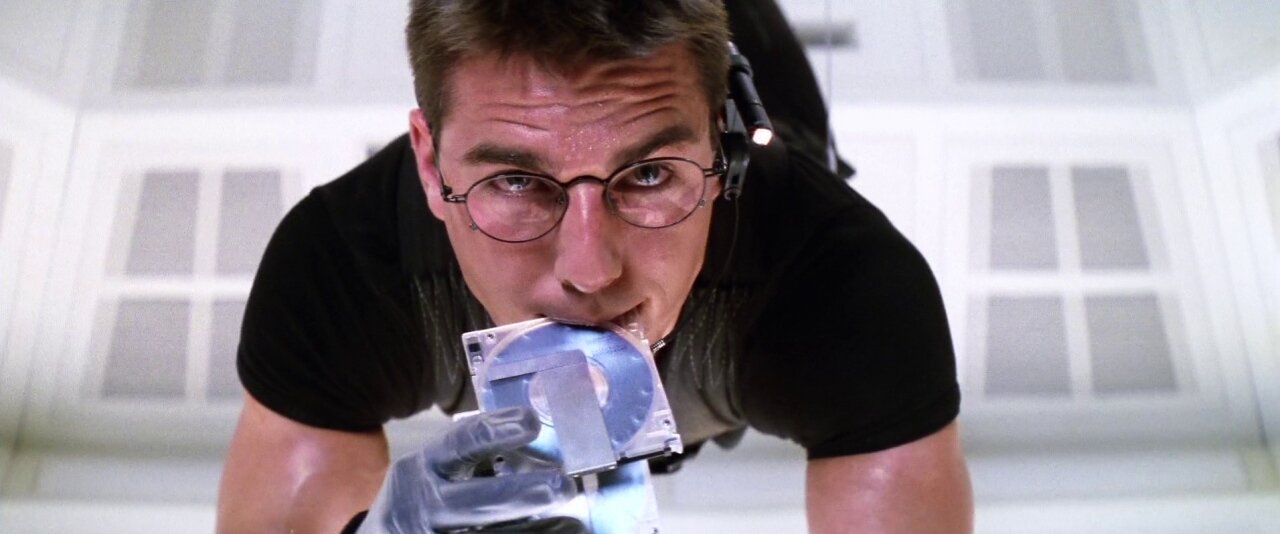Mission: Impossible (1996, Brian De Palma)
As episodic as the titular series, Brian De Palma’s Mission: Impossible is a compendium of indelible set pieces, each as elaborate as the ever-shifting personas of his spy protagonists. Adhering to action in lieu of story, De Palma manipulates what is seen through misdirection and subjective visual perspective, allowing the viewer to construct their own false narrative. Technological advancements are also exploited in the name of fostering paranoia, predicting a world where truth is impossible to discern, easily doctored, and readily ignored. Employing form to comment on the text and camera angle to experiment with mood, Mission: Impossible is a rarity among blockbusters, not as idiosyncratic as Bram Stoker’s Dracula, but no less fascinated by atmospherics and the symbiotic relationship between enchantment and deception.
Deceit is the only certainty in the world of espionage, explicated in the film’s commencing masquerade of staged murders, rubber masks, and false walls. Exhibiting this ruse through grainy closed-circuit television further cements the fallibility of the human eye, demonstrating the role visual displays have in corrupting fact and obscuring detail. Cameras are as integral in this game of misdirection, both the withholding eye of De Palma’s omniscient Panaflex Platinum and the dubious images captured by his characters’ body cams.
Shot choice and positioning of the camera are just as disorienting, shifting from the deep focus of Split Diopters, to the jagged vertical lines of the Dutch tilt, to shadowy, furrowed low angles. Aesthetics are as much a contest to De Palma as scamming the CIA is to the film’s standard-bearer (Tom Cruise’s indefatigable Ethan Hunt), and he modernizes old tricks to keep up with emerging technologies. Capturing multiple characters’ points of view on a single screen prophesied the teleconferences of the future, except De Palma reflects the anonymity of the profession by disembodying the visual action from the human visage.
Equally foreign and bewildering is the labyrinthine location. Prague’s cobblestone streets, unbound by the rigidity of American city planning, carry the mystique of history and desolation, populated only by a dense layer of stage fog that heightens tension and intensifies ambience. Color is also used to conjure mood and symbol, specifically in the Akvarium café sequence, which employs soft neons and glacial blues to reflect cold detachment and the chill of betrayal.
This potential for perfidy hangs over the film like a specter, transforming every exchange into a stratagem of half truths and false pleasantries. Ultimately, the sole motivation of the undercover operative is autonomy, both in the psychological and philosophical sense, since consolidation leaves one vulnerable to exposure. De Palma captures the genuine dread at the core of this fantasy scenario, predicting a future where intimacy is replaced by connectivity, and the previously private is laid bare.
Sexuality, once De Palma’s primary release and preoccupation, is inhibited by accessibility, reflected in the hypertension of a hero who relishes the tease, but never samples “the goods.” We’re just as captivated by the distraction, drawn down dead-ends by a lavish game of hide-and-seek. The true frisson lies just beneath the surface, taking root in parallels between the esoteric and familiar, magnifying our own fears by shrouding them in horse feathers.
Mission: Impossible (Paramount Pictures, 1996)
Directed by Brian De Palma
Written by Bruce Geller (based on his television series “Mission: Impossible”), David Koepp (screenplay and story), Robert Towne (screenplay), and Steven Zaillian (story)
Photographed by Stephen H. Burum
We'd like to thank FilmGrab for the high-res screengrabs!




















